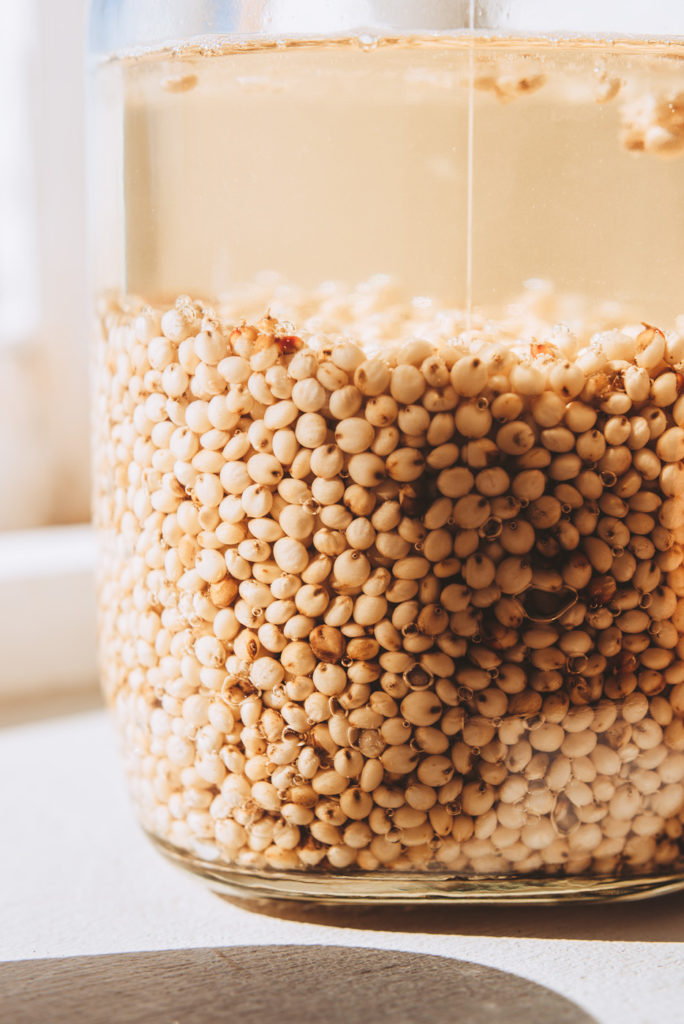Amidst fields of crops around the world, sorghum is an ancient grain that has scattered its seeds of knowledge, ritual and security. Generations of women have harnessed its vigor, and with climate change rippling through our natural environment, how do we nourish ourselves in ways that are reflected in these realities?
Sorghum is a naturally gluten-free grain that is able to thrive within arid regions and under drought conditions. Widely considered to have been domesticated in the Sudanian savanna of the Sahel region as early as 4000 B.C, the production of sorghum played a significant role in the expansion of Indigenous peoples as they moved along trade routes across Sub-Saharan Africa. Today, sorghum is cultivated across the globe in warmer climatic territories and is one of the world’s most important grains; it’s the fifth most produced worldwide, after maize, wheat, rice (milled) and barley. It is exceptionally versatile as it can be ground into flour, boiled as one would rice or quinoa, popped as you would popcorn, and prepared into an alternative sweetener through pressing its stalks or plant juice into a molasses or syrup.


In Africa, sorghum is largely a subsistence food crop. It has a nutrient profile that boasts high levels of antioxidants, fiber, vitamin B, magnesium and protein for energy production as well as heart, gut, skin and hair health. Even though it holds boundless potential to drive economic development and capacity to stand as the cornerstone of food security across the continent, the sovereignty of sorghum has somewhat been forgotten. This can be attributed to the popularization of maize when it was introduced to Africa by way of the Columbian Exchange. Not only did the average country experience 22% population growth from 1600 to 1900 and a 6% increase in slave exports at the height of the slave trades, maize was cultivated across most of the African continent by the early 1700s.
In South Africa, sorghum is popularly consumed in the form of traditional fermented porridge known as ting ya mabele, as well as traditionally brewed beer known as lentsene in Setlokwa—a dialect of Sepedi in the Limpopo province—or umqombothi in isiZulu. It is not uncommon to hear young Black peers cite the taste of ting ya mabele as a homecoming, with wholesome memories of mothers and grandmothers fermenting tiny buckets of the grain in refrigerators and dark nooks around their kitchens.
Fond memories such as these are an integral part of how 26-year-old Queen Finxa conceived The Sorghum Agenda, a passion project and ongoing digital campaign that has garnered over 4,000 followers. Finxa is a chef, consumer scientist, and recipe developer who was raised in a South African Basotho home. Having developed gut disturbances in 2017, which were later diagnosed as a wheat allergy, she quickly found that traces of wheat were laced into various alternative ingredients she was working with. Like many, she grew up with fermented sorghum as a daily ritual within her grandmother’s home, albeit one that is often forgotten by upwardly mobile young Black people.



This inspired The Sorghum Agenda, with a broader aim to, according to Finxa, “encourage more people to eat sorghum and other indigenous grains. To move beyond the mentality that it’s a food item reserved for ‘poor’ people, and instead realize the true wealth in buying and consuming indigenous grains such as Sorghum. From helping the local farmers who grow it, to being a more sustainable grain, and most importantly, being kind to the gut.”
The ritual of soaking and fermenting sorghum is an ode to the evolution of this everyday dish. It is a distinct ceremonial food that is often laid at the banquet table during significant spiritual and cultural family affairs. At weddings and the handing over of lobola (dowry), initiation school graduation celebrations, funerals and births, and customary rain-making ceremonies, ting ya mabele and lentsene are used to pay tribute to our ancestors—to invite and express gratitude for their presence at these events
It is not by providence that the reminiscence around sorghum is frequently attached to maternal figures in the home. Family matriarchs are the ones who prepare ting ya mabele and brew lentsene. And while the process of brewing may bear similarities across several South African cultural groups, recipes and techniques are often passed from one generation to the next through oral instruction. Many women in rural areas have also relied on lentsene as a source of household income, with mothers-in-law teaching their new daughters in order to preserve the making of this sacred drink for generations to come.
In light of Black South Africans’ mass voluntary migration to urban areas for better infrastructure and services after the end of the apartheid era in 1994, the legacy of sorghum has slowly faded away from its rural roots and traditions. Climate change researchers are increasingly aware that gender is a crucial variable to consider within climate change analyses. Agriculture is the greatest source of income in the developing world, yet one of the gravest impacts of climate change has been on agricultural productivity, with temperatures rising higher than the global average. With an overall Black population of over 81%, women make up 52% of those living below the poverty line. And although women depend on and contribute 60 to 80% of the labor force in agriculture for food security and household livelihoods, the gender variable dictates they be overlooked as contributors. This is exacerbated by gendered social norms and inequalities which render women less likely to receive agricultural support than their male counterparts.


In countries such as South Africa, the impact of popularizing maize has had a reverberating food apartheid effect. Sorghum has not been developed into a major food source within urban areas, even though its nutrient and sustainability properties are superior to those of maize. In essence, without reassessing marginal crops such as sorghum and liaising with small-scale farmers, academics and national agricultural organizations, the most marginalized members of communities—women and children— will continue to carry the bulk of the burdens of climate change. Still, when supported, they have managed to achieve household food security and to assert food sovereignty by turning to sorghum as the bedrock of their strategies, as in Sudan, Nigeria and Zimbabwe, especially in light of the negative impact warmer weather has had on the production of maize.
Being the only Black student in the final year of her consumer sciences class, Finxa began walking her own path toward The Sorghum Agenda when she created sorghum cookies—an unconventional feat as she had never seen sorghum cookies on the commercial market—for a major project. Her first batch of cookies was a colossal flop marked by an inedible texture, but she persevered. “The more I was working with sorghum,” she explains, “I was learning that because it’s indigenous to us, it works so much better for our bodies, between regulating our blood sugars, keeping us fuller for longer, to how safe it is for our environment.”

In a four-year academic program at the University of Pretoria where Finxa received extensive instruction in a range of Western cuisines, the span of her formal instruction on African cuisine—as set by the curriculum—lasted only a week. Following the project, she went on to win an award for having the most creative and innovative recipe development, which saw her creating a restaurant at her university for a diverse group of academic diners from various parts of the world. It was here where she opted to showcase the legacy of sorghum, with a Mosotho in the City-themed dining experience dedicated to her grandmother.
Over the 14 weeks it took to develop her sorghum cookies between 2018 and 2019, Finxa’s thought process extended beyond the recipe before her. “South Africa was going through a dry season, the Vaal Dam’s water levels were the lowest they had ever been, and Cape Town had just gone through a drought,” she says. “It got me thinking about the people growing it in Limpopo—that this could be such a great market for them. Increasing demand increases supply, and that creates a natural local economy that allows us to support our own.” Beyond encouraging people to consume more indigenous grains, she began viewing The Sorghum Agenda as a way to stimulate the commercial market and potentially drive demand. By meeting younger people where they are at—on the digital space—she has already worked with brands Local Village Foods and Native Nosi Honey Emporium—two Black female-owned companies whose ingredients she utilizes in the recipes she develops and showcases. These companies source 90% of their indigeous foods from small-scale farmers in South Africa and other African countries including Nigeria, Malawi, Zimbabwe and Benin, as well as source honey from South African rural beekeepers.

“When my white peers walked into the kitchen while I was preparing for the dining experience, I would hear, ‘Ew, what’s that smell? Did something go off in the fridge?’ while preparing fermented sorghum,” Finxa says. This may speak to a lack of exposure in the academic environment, where research and learning are not rigorously geared toward the African context, are Eurocentric in nature, and thus produces professionals who may not be in touch with the needs of a broader society. But it also exposes an added, more powerful layer pertaining to the language around indigenous food that Finxa aims to challenge: “When it comes to African foods, you’ll often hear that it’s not marketable, it’s not going to reach, or it’s not attractive.” This bears some impact on the notion of food sovereignty as Indigenous people may internalize messages around our foods being “dirty” and “unrefined.” Whereas brief shifts in food trends push Indigenous people aside. “When African foods do enter the market, they immediately go to high-end restaurants, where the people who work with the food and who eat it traditionally cannot afford it,” explains Finxa.
This is where The Sorghum Agenda confronts younger Black South Africans’ internalized ideas around those indigenous foods many are raised with. When Finxa initially created the sorghum cookies, many of her peers expressed their hesitation. Except by the time she developed the recipe enough to place a pilot batch on sale, they were sold out before she could advertise them on her social media platforms. And so she has pursued numerous other recipe inquiries. “What started out as cookies soon grew into steamed and sourdough breads, waffles, chocolate brownies, and even more cookies,” she says. “You don’t see your traditional beer and think: I could make dessert with that!”
Ultimately, Finxa’s steadily blossoming Sorghum Agenda is only the beginning of re-imaging an African context that elevates the voices of Black women—specifically within the realm of indigenous knowledge systems around crop production. We may learn in academic spaces and through digital campaigns about some of the work that is taking place to harness the wealth of sorghum within a changing climate, but as Finxa asserts, it is pivotal to pay homage to those matriarchal figures who so many of us remember when we think of this grain in its simplest forms. Those women who did not step into academic spaces in order to construct their knowledge around indigenous foods. Because, Finxa poses, “if they were informed enough to tell you and to explain it to you does that still mean they are uneducated?”
“It’s a matter of us—and this is how I’m trying to contribute my voice—saying our food matters as it is,” she adds. “You don’t have to refine because it doesn’t need refining. It’s delicious and it’s healthy and it’s wholesome and it’s food we’ve eaten together for centuries.”







Our comments section is for members only.
Join today to gain exclusive access.